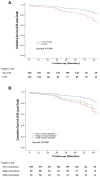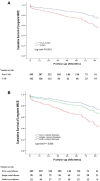Coronary artery disease as an independent predictor of short-term and long-term outcomes in patients with type-B aortic dissection undergoing thoracic endovascular repair
- PMID: 36588578
- PMCID: PMC9795049
- DOI: 10.3389/fcvm.2022.1041706
Coronary artery disease as an independent predictor of short-term and long-term outcomes in patients with type-B aortic dissection undergoing thoracic endovascular repair
Abstract
Background and aims: Previous studies reported a high prevalence of concomitant coronary artery disease (CAD) in patients with Type B aortic dissection (TBAD). However, there is too limited data on the impact of CAD on prognosis in patients with TBAD. The present study aimed to assess the short-term and long-term impact of CAD on patients with acute or subacute TBAD undergoing thoracic endovascular aortic repair (TEVAR).
Methods: We retrospectively evaluated 463 patients with acute or subacute TBAD undergoing TEVAR from a prospectively maintained database from 2010 to 2017. CAD was defined before TEVAR by coronary angiography. Multivariable logistic and cox regression analyses were performed to evaluate the relationship between CAD and the short-term as well as long-term outcomes.
Results: According to the results of coronary angiography, the 463 patients were divided into the following two groups: CAD group (N = 148), non-CAD group (N = 315). In total, 12 (2.6%) in-hospital deaths and 54 (12%) all-cause deaths following a median follow-up of 48.1 months were recorded. Multivariable analysis revealed that CAD was an independent predictor of in-hospital major adverse clinical events (MACE) (odd ratio [OR], 2.33; 95% confidence interval [CI], 1.07-5.08; p = 0.033), long-term mortality [hazard ratio (HR), 2.11, 95% CI, 1.19-3.74, P = 0.011] and long-term MACE (HR, 1.95, 95% CI, 1.26-3.02, P = 0.003). To further clarify the relationship between the severity of CAD and long-term outcomes, we categorized patients into three groups: zero-vessel disease, single-vessel disease and multi-vessel disease. The long-term mortality (9.7 vs. 14.4 vs. 21.2%, P = 0.045), and long-term MACE (16.8 vs. 22.2 vs. 40.4%, P = 0.001) increased with the number of identified stenosed coronary vessels. Multivariable analysis indicated that, multi-vessel disease was independently associated with long-term mortality (HR, 2.38, 95% CI, 1.16-4.89, P = 0.018) and long-term MACE (HR, 2.79, 95% CI, 1.65-4.73, P = 0.001), compared with zero-vessel disease.
Conclusions: CAD was associated with short-term and long-term worse outcomes in patients with acute or subacute TBAD undergoing TEVAR. Furthermore, the severity of CAD was also associated with worse long-term prognosis. Therefore, CAD could be considered as a useful independent predictor for pre-TEVAR risk stratification in patients with TBAD.
Keywords: coronary artery disease; predictor; prognosis; thoracic endovascular aortic repair; type B aortic dissection.
Copyright © 2022 Li, Luo, Lin, Su, Xu, Hu, Liu, Huang, Luo and Zhou.
Conflict of interest statement
The authors declare that the research was conducted in the absence of any commercial or financial relationships that could be construed as a potential conflict of interest.
Figures





References
-
- Erbel R, Aboyans V, Boileau C, Bossone E, Bartolomeo RD, Eggebrecht H, et al. . 2014 ESC Guidelines on the diagnosis and treatment of aortic diseases: document covering acute and chronic aortic diseases of the thoracic and abdominal aorta of the adult. The task force for the diagnosis and treatment of aortic diseases of the European society of cardiology (ESC). Eur Heart J. (2014) 35:2873–926. 10.1093/eurheartj/ehu281 - DOI - PubMed
-
- Kojima S, Suwa S, Fujiwara Y, Inoue K, Mineda Y, Ohta H, et al. . [Incidence and severity of coronary artery disease in patients with acute aortic dissection: comparison with abdominal aortic aneurysm and arteriosclerosis obliterans]. J Cardiol. (2001) 37:165–71. - PubMed
LinkOut - more resources
Full Text Sources
Miscellaneous

